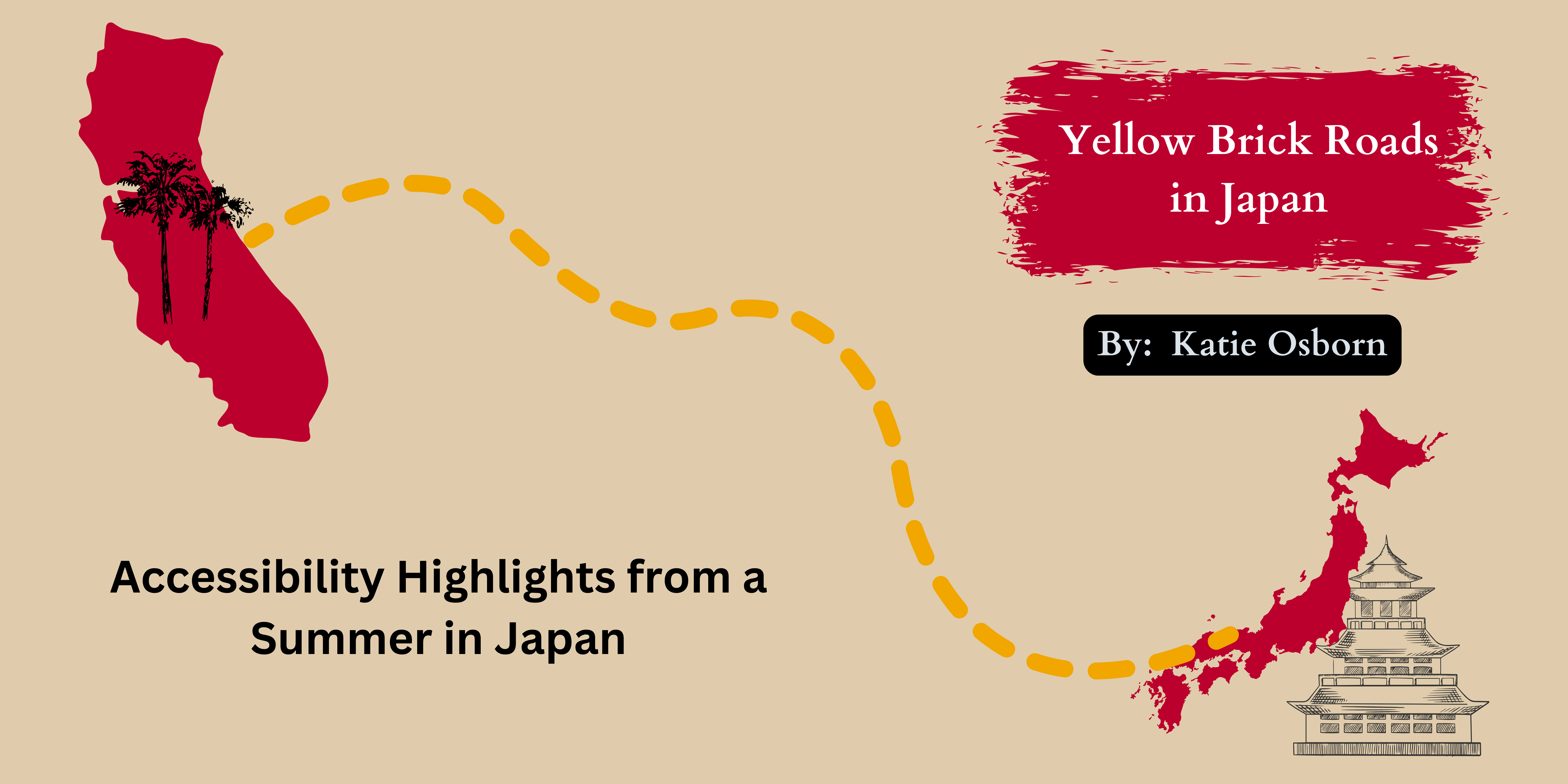
By: Katie Osborn
During the summer of 2023 I spent five weeks in Japan, and although I was primarily there to teach English for a cultural immersion program, I was also on a secret mission of my own: accessibility scouting. Japan is known for its advanced technology and incredibly efficient infrastructure — but how about its accessibility for people with disabilities?
Over those five weeks, I navigated through some of the most accessible bathrooms I had ever seen in public spaces such as train stations and malls — and some of the least accessible in more rural areas and small shops. I noticed Japanese Braille on just about every informational sign or area with a function, but also watched a friend struggle to get around public areas with an injured ankle. How could something be so accessible and yet so inaccessible at the same time? Crosswalks had regionally varying melodies played during the walk interval, sometimes accompanied by street names, yet many people in my program had trouble getting around Japan with suitcases or heavy items due to the high concentration of bumpy yellow lines on the ground. There were elevators in every train station I entered — but when one was undergoing maintenance with caution tape stretched over it, there was no other way to get down except via the three long flights of stairs. What good is an accessible option when there is no plan B if it fails? Trains and buses are all wheelchair friendly, with specific areas designated for different physical needs, but some stations were so flooded with people that it seemed impossible to navigate through them even as an able-bodied person. My observations in Japan seemed paradoxical by nature, and I often found myself stumped for an answer to my original question.
When I got back from Japan and gathered my thoughts about accessibility, I did some more research to determine my key takeaway. And, with one simple google search from the comfort of my apartment back in LA, I realized that I had missed one of the most prominent, important, and widespread accessibility inventions that had been, quite literally, right beneath my nose. While somehow my own able-bodied ignorance couldn’t comprehend the use for them, despite seeing them everywhere, I finally realized what I had missed all along: tactile pavings.
Annnnnnd….. cue the memories of my friends complaining about dragging their suitcases across those seemingly pointless raised yellow lines all around the stations. I myself avoided them as much as possible when I was carrying my luggage from city to city, but I can guarantee that every single day that I was in Japan, there were at least a few yellow tactiles in my peripheral vision. In fact, I can’t picture a station or street without them stretching over the ground like a web of flattened lego bricks.
Ironically, while those yellow squares seemed like a minor inconvenience to my able-bodied friends and I, they are actually one of Japan’s greatest accessibility contributions to the world. And, as I now know, they are awesome.
In 1967 Seiichi Miyake, a Japanese engineer and inventor, invested his own money into a project inspired by a friend who was partially blind. He created Tenji blocks, or brightly colored patterns in the form of textured lines or circles installed on the ground to help blind people navigate through the streets.
There are two types of Tenji blocks:
- Dotted blocks, or “truncated domes,” which indicate caution. These may be placed next to a curb, ramp, or other change in surface.
Image
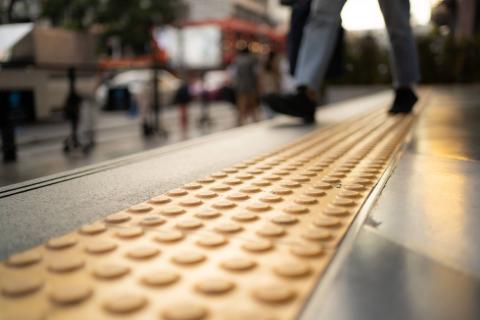
| Image

|
- Parallel bars, which give directional cues and indicate a safe path.
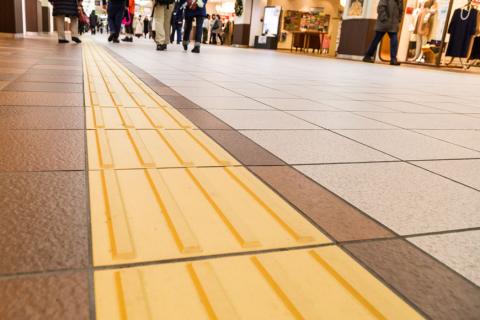
Both blocks are colored bright yellow to guide those with moderate to severe loss of vision.
Miyake’s Tenji Blocks were first installed in 1967 along a highway by the Okayama School for the Blind, and a few years later, the blocks could be seen at every Japanese railway platform. In 1985, five years before the Americans with Disabilities Act (ADA) was signed, the Tenji Blocks were mandated for nationwide use, although a national design standard wasn’t initiated until 2001.
In the 1990s, Tenji Blocks made their way across the globe to the United Kingdom, Australia, and the United States, and became otherwise known as tactile pavings. The dotted blocks and parallel bars are the most widespread pavings, although some countries have implemented more variations for specific scenarios. For example, the United Kingdom has six official types of tactile pavings:
- Blister Surface: Used to indicate a pedestrian crossing

- Corduroy Hazard Warning Surface: Used to indicate nearby hazards such as steps
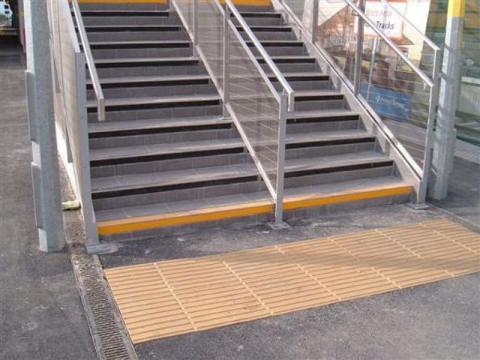
- Platform Edge (On-Street) Warning Surface: Used to indicate the edge of a transit rail on the street
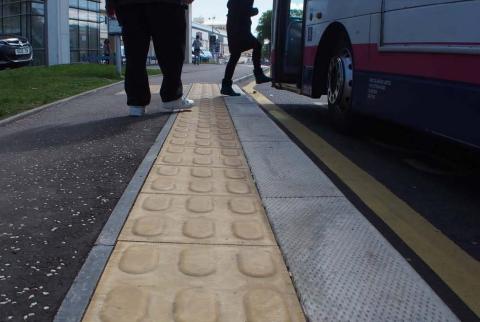
- Platform Edge (Off-Street) Warning Surface: Used to indicate the edge of a rail platform
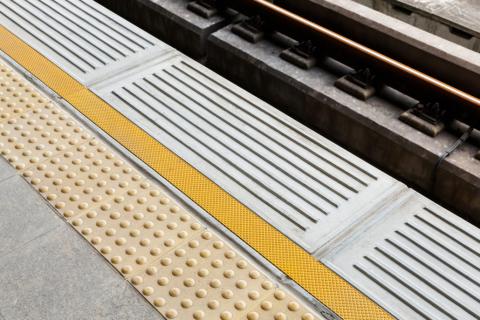
- Segregated Shared Cycle Track/ Footway Surface: Used to distinguish between pedestrian and cyclist pathways

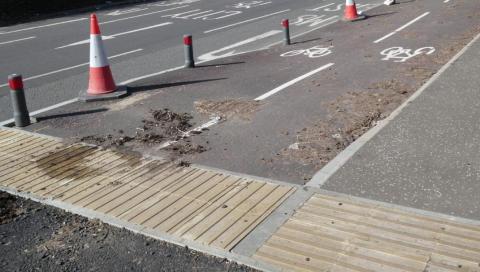
- Guidance Path Surface: Used to guide pedestrians directionally
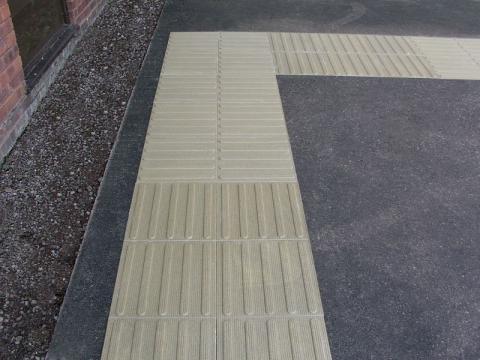
Although their system isn’t as vast and complex as the U.K. or Japan, in the U.S., you may recognize tactile pavings as the curb cut bumps next to cross walks:
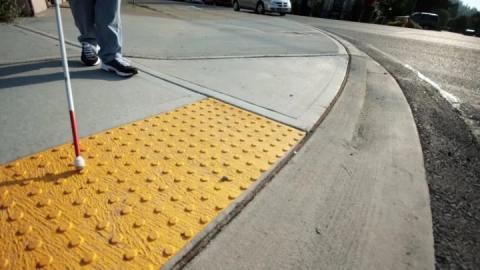
Now, decades after their creation, tactile pavings have been implemented in every continent (not 100% certain about Antarctica).
So, how did I somehow miss the significance of these Tenji Blocks all over Japan while I was on the hunt for accessible systems? Perhaps it was my own oblivion to something that seemed so normalized in Japan, I didn’t even question its function. Perhaps it was because the tactile pavings in America hardly compare to the magnitude and intricacy of those in Japan — I didn’t even register them to be the same thing. Or perhaps it was the subconscious, minorly negative association I developed after another coach in the program warned me to “avoid dragging your suitcase over all the yellow lines” because they were “so annoying.” Well, I soon learned that carrying a heavy suitcase up and down stairs and onto a crowded train was much more inconvenient, and that more often than not I didn’t even need to drag my suitcase across the pavings — I could move parallel to them instead. Even though I may not have learned the power of the Tenji Blocks until my arrival back in the United States, now that I do know the story behind Tenji blocks, I don’t think I can ever not notice (and appreciate!) those bright yellow squares again.
But hold up – the tale of tactile pavings does not end here. While it's one thing to appreciate this universal design, there are still so many people out there who don't understand the significance of tactile pavings or why we need to implement more inclusive designs into all facets of society in order to combat uneducated assumptions about accessibility. While a tactile paving near a curb cut may slightly inconvenience your skateboard commute to class, it grants autonomy and safety to a blind individual.
So, while I hope you enjoyed learning about tactile pavings, as I did, I hope you can also empower yourself and others around you by advocating for more universal access to accessible design on a local, national, and even global scale. At the very least, let’s advocate for more diverse and versatile tactile pavings in the U.S. – Japan and the UK are already doing it, so why can’t we?
Orignal Posted: 22 February 2024
Picture Sources
Dotted blocks: The Japan Times
Parallel Bars: Reliance Foundry and Japan Up Close
Blister Surface: Visual Systems
Corduroy Hazard Warning Surface: Sure Grip
Platform Edge (On-Street) Warning Surface: Marshalls UK
Platform Edge (Off-Street) Warning Surface: SureWerx
Segregated Shared Cycle Track/ Footway Surface: Designing Buildings Ltd. & GoBike
Guidance Path Surface: Sure Grip
US Tactile Paving: Mental Floss

